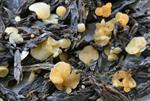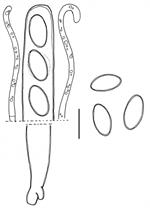
Coll. NV 2014.08.02 (leg. M. Meyer)
© N. Van Vooren | 
Coll. NV 2014.08.02
Microcharacters 10 µm
© N. Van Vooren | | | | |
Boubovia nicholsonii (Massee) Spooner & Y.J. Yao, Mycol. Res., 100 (2): 194 (1996).
Basionym Humaria nicholsonii Massee, Naturalist (Hull), 1901: 188 (1901).
Diagnosis Humaria nicholsonii Massee (sp. nov.). Pl. 2, figs. 17-21.
Gregarious, sessile, fleshy, globose at first, gradually becoming plane, or sometimes slightly convex, marginate, glabrous, 4-7 mm. Across, orange-yellow, cortex parenchymatous, cells averaging 6-7 µ diameter; asci cylindrical, 8-spored, 65-70 × 8-9 µ; spores elliptical, smooth, hyaline, ends obtuse, 1-guttulate, 10 × 6 µ; paraphyses filiform, apex not thickened.
On dead beech leaves, Kew Gardens (G. Nicholson).
Well defined by the small asci and spores, and the small cells of the cortex. Not very near to any other known species.
Type leg. Nicholson, 1898 (K) - holotypus
MycoBank 434362
Literature
Massee G., Crossland C. 1901. New British Discomycetes. Part I. The Naturalist, 1901: 177-189.
Yao Y.J., Spooner B.M. 1996. Delimitation of Boubovia and Pulvinula. Mycological Research, 100 (2): 193-194.
Zhuang W.Y. 2002. Some new species and new records of discomycetes in China. X. Mycosystema, 21 (4): 475-479.
Classification: Coprotaceae, Boubovia
Created on 23/05/2015.
Updated on 01/08/2023.
